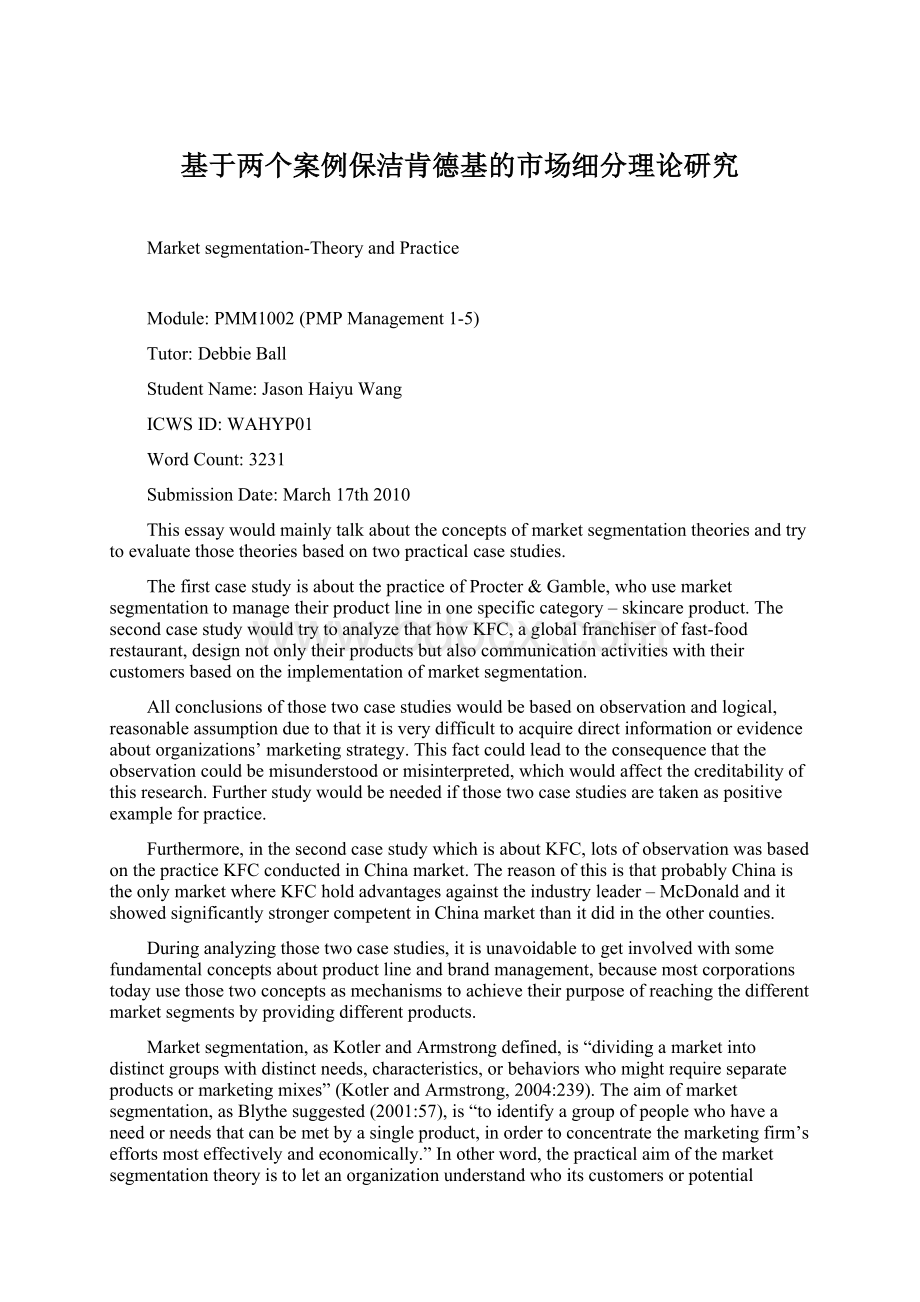基于两个案例保洁肯德基的市场细分理论研究Word文件下载.docx
《基于两个案例保洁肯德基的市场细分理论研究Word文件下载.docx》由会员分享,可在线阅读,更多相关《基于两个案例保洁肯德基的市场细分理论研究Word文件下载.docx(13页珍藏版)》请在冰豆网上搜索。

PMM1002
(PMPManagement1-5)
Tutor:
DebbieBall
StudentName:
JasonHaiyuWang
ICWSID:
WAHYP01
WordCount:
3231
SubmissionDate:
March17th2010
Thisessaywouldmainlytalkabouttheconceptsofmarketsegmentationtheoriesandtrytoevaluatethosetheoriesbasedontwopracticalcasestudies.
ThefirstcasestudyisaboutthepracticeofProcter&
Gamble,whousemarketsegmentationtomanagetheirproductlineinonespecificcategory–skincareproduct.ThesecondcasestudywouldtrytoanalyzethathowKFC,aglobalfranchiseroffast-foodrestaurant,designnotonlytheirproductsbutalsocommunicationactivitieswiththeircustomersbasedontheimplementationofmarketsegmentation.
Allconclusionsofthosetwocasestudieswouldbebasedonobservationandlogical,reasonableassumptionduetothatitisverydifficulttoacquiredirectinformationorevidenceaboutorganizations’marketingstrategy.Thisfactcouldleadtotheconsequencethattheobservationcouldbemisunderstoodormisinterpreted,whichwouldaffectthecreditabilityofthisresearch.Furtherstudywouldbeneededifthosetwocasestudiesaretakenaspositiveexampleforpractice.
Furthermore,inthesecondcasestudywhichisaboutKFC,lotsofobservationwasbasedonthepracticeKFCconductedinChinamarket.ThereasonofthisisthatprobablyChinaistheonlymarketwhereKFCholdadvantagesagainsttheindustryleader–McDonaldanditshowedsignificantlystrongercompetentinChinamarketthanitdidintheothercounties.
Duringanalyzingthosetwocasestudies,itisunavoidabletogetinvolvedwithsomefundamentalconceptsaboutproductlineandbrandmanagement,becausemostcorporationstodayusethosetwoconceptsasmechanismstoachievetheirpurposeofreachingthedifferentmarketsegmentsbyprovidingdifferentproducts.
Marketsegmentation,asKotlerandArmstrongdefined,is“dividingamarketintodistinctgroupswithdistinctneeds,characteristics,orbehaviorswhomightrequireseparateproductsormarketingmixes”(KotlerandArmstrong,2004:
239).Theaimofmarketsegmentation,asBlythesuggested(2001:
57),is“toidentifyagroupofpeoplewhohaveaneedorneedsthatcanbemetbyasingleproduct,inordertoconcentratethemarketingfirm’seffortsmosteffectivelyandeconomically.”Inotherword,thepracticalaimofthemarketsegmentationtheoryistoletanorganizationunderstandwhoitscustomersorpotentialcustomersareandtogivesuggestionsabouthowtofulfillthosepeople’sneedsinthemosteffectiveandefficientways.AsBlytheimplied,bymarketsegmentationapproaches,organizationscouldenhanceandimprovetheirmarketingefficiency,whichcouldbebeneficialtotheirbusinessandprovidecompetentorbringcompetitiveadvantagestothemselves.Hence,mostoforganizationsconsideredmarketsegmentationasoneoftheirmostcrucialcompositionsoftheirmarketingstrategies.
Fromlatenineteencenturyto1940s,lotsofcorporationgottheirownsuccessfromimplementingAmericansystemof
manufacturing,whichfocusedonprovidingstandardproductswithlowpricesbasedoncostcontrolandimprovingmanufacturingefficiency.However,inthe1950s,somepeoplefoundthatthebusinessenvironmenthadchangedwhenlotsofconsumerswouldnotbesatisfiedbystandardizedproductsanymoreanddemandmoreselectionvariety.In1956,Smithintroducedtheconceptofmarketsegmentation,whichwasashestated“marketsegmentationinvolvedviewingaheterogeneousmarketasanumberofsmallerhomogeneousmarkets,inresponsetodifferingpreferences,attributabletothedesiresofconsumersformoreprecisesatisfactionoftheirvaryingwants”(Smith,1956).Sincethen,theconceptofmarketsegmentationhasbecomeoneofthemostimportantmarketingtheoriesinboththeoreticalandpracticalfield.
Adcock,Halborg,andRossin2001suggestedthatthoughthereisnolimittothenumberofmeasurestosegmentthemarketinparticularcircumstances,however,unlessasegmentbedefinable,sizable,reachableandrelevant,itwouldbeuselessinthepracticalfield.
Definablemeanspeoplemustbeabletodescribethemarketsegment,andforthisthekeycharacteristicsofthesegmentshouldshowadegreeofhomogeneity.Thesegmentisofcourseasubsetofaheterogeneoustotalmarketforthereasonthatifthetotalmarketwerehomogeneoustherewouldbenoneedforsegmentation.Itisalsousefultobeabletomeasurethemarketsizeanddefinetheboundariesofthesegment.Sizablemeansthatthemarketsegmentmustbebigenoughforanorganizationtogetprofitfromitbyprovidingcommoditiesandservices.Thiscriterionwouldbedifferenttothedifferentorganizationbecauseoftheirsizeandthegoodsorservicestheyoffered.Reachablemeansthattheremustbeawayofreachingthesegmentbotheffectivelyandefficiently.Thisincludestheobviousphysicaldistributionofaproduct,aswellascommunicatingwithcustomersviamediaorinadirectway.Relevanthereisconsideredthemostimportanttestforanydescribedsegment.Itcannotbeconsideredinisolationfromtheothercriteriaasthereisnopointindescribingarelevantsegmentthatcannotbereached(KotlerandArmstrong,2004).
Thebasicprincipleofsegmentationisverysimple.BasedontheideafromAdcock,Halborg,andRoss(2001),itinvolvesselectingtheclassificationmostappropriatetothegroupsofcustomersidentified.Theworkinvolvedindoingthisisjustifiedonlyifitcanbeusedtoimprovemarketingeffectiveness.
BasedonWedelandKamakura’stheory(2000),themarketsegmentationbasescanbedividedintofourdifferentclassesbywhetheritisobservabletothemarketersornotandwhetheritwasmainlyconcernedaboutaspecificproduct.Theydevelopedamatrixtoshowthisconclusion(Figure1).
Figure1,Classificationofsegmentationbases
General
Product-specific
Observable
Cultural,Geographic,Demographic,andSocio-economicvariables
Userstatus,Usagefrequency,Storeloyaltyandpatronage,Situations
Unobservable
Psychographics,Values,PersonalityandLife-style
Psychographics,Benefits,Perceptions,Elasticities,Attributes,PreferenceandIntention
Asegmentationbasisisdefinedasasetofvariablesorcharacteristicsusedtoassignpotentialcustomerstohomogeneousgroup.FollowingFrank,MassyandWind(inWedelandKamakura,2000),WedelandKamakuraclassifysegmentationbasesintogeneral(independentofproducts,servicesorcircumstances)andproduct-specific(relatedtoboththecustomerandtheproduct,serviceand/orparticularcircumstances)bases.Furthermore,theyclassifybasesintowhethertheyareobservable(i.e.,measureddirectly)orunobservable(i.e.,inferred).Thattypologyholdsforthebasesusedforsegmentationofbothconsumerandindustrialmarkets,althoughtheintensitywithwhichvariousbasesareuseddiffersacrossthetwotypesofmarkets.
Almostinthesametime,Adcock,Halborg,andRoss(2001)holdaslightlydifferentopinionabouttheclassificationofmarketsegmentation.Theysuggestedthatthereweretwodifferenttypesofmarketsegmentation.Oneisthetraditionalapproach,whichusevariablesandcanbedescribedasgeographicand/ordemographic;
theotheroneismodernapproachwhichisbecomingmoreusualtoclassifyconsumersonthebasisofself-orientationandresources.Intheiropinion,therewassomeproblemswiththetraditionalapproachnowadaysbecauseoftheworldhadchangedsofastinthelastcoupleofdecades.
Althoughscholarsholddifferentopinionsabouthowthemarketsegmentationbasesshouldbeclassified,thereweresomevariablestheyalluseasthecriteriafordifferentmarketsegmentationbases.E.g.age,gender,race,familysize,income,occupation,education,religion,generation,nationalityandlifecycleforthedemographicbases;
ACORNandPRIZMforgeo-demographicsbases;
worldregionorcountry,countryregion,cityormetrosize,densityandclimateforthegeographicbases;
VALS2,socialclassandpersonalityforthepsychographicbases;
and,occasions,benefits,userstatus,usagerates,loyaltystatus,readinessstageandattitudetowardsproductforthebehavioralbases(KotlerandArmstrong2004:
240).
Evenlotsofpeopleagreedthosevariablescouldbeusedinmarketsegmentationpractice,theyalsohaddifferentideaaboutthem.Forinstance,accordingtoKotlerandArmstrong(2004),consumers’needsandwantswouldchangewithage.Therefore,organizationshouldofferdifferentproductsorusedifferentmarketingapproachesfordifferentagegroups.Andtheyprovidedsomesuccessfulpracticesofsomemultinationalcorporationwhouseageasavariablefortheirmarketsegmentation.However,Davies(1998)statedthatagemustbeusedwithcautionthoughitcanbeusedasameansfordistinguishingbetweentheneedsofdifferentgroupsandsegments.HementionedareportbyMintel(inDavies,1998)whichwasentitled‘theover50s’(1989),anexecutivesummary’,whichdiscoveredthatmediaportrayalsofthisgroupasmaturecitizenswasoftenresented.Thereportelaboratesthatasignificantnumberinthisgroupfindlifemoresatisfyingthanwhentheywereyounger.Moreover,hementionedthat“manypeopleinlatemiddle-ageconsiderthistobeatimefor“selfish”spendingandachancetoindulgethemselveswithaclearconscience,particularlywhentheydonothavetoworryaboutfamilyresponsibilities.AlsohereferredatheoryoriginatedbyanAmericanprofessorofmarketing,Moschis,whichisthatmarketersneedtooffermarketingofferingthatarestimulatedbythecognitiveagesofindividualsinsteadoftheirchronologicalages.Cognitiveagerefertohowo